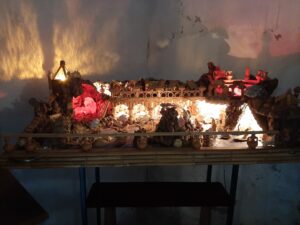The Church of Saint Anthony Abbot in Taormina: a hidden gem of history, art, and tradition
In the heart of Taormina, just beyond Porta Catania, stands a small church steeped in centuries of history and a deeply Sicilian soul. Built in 1330, it is one of the city’s oldest monuments and a prime example of eclectic architecture, where Gothic, Baroque, and Byzantine elements blend in surprising harmony.
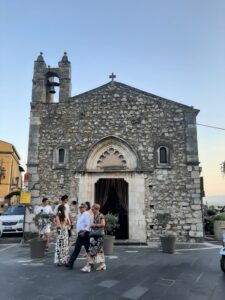 A story that stands the test of time
A story that stands the test of time
The church was constructed along Taormina’s southern defensive wall, near the gate-tower named after the saint. In 1943, during World War II, it was heavily damaged by bombing. As is often the case with places that guard collective memory, it was rebuilt using the original stones salvaged from the rubble, preserving its identity.
The white limestone portal, framed in black lava stone and topped with a pointed arch decorated with small arches, recalls the Gothic style of Taormina’s Cathedral. The lead-sheeted windows, perforated in ornate patterns, are a rare example of Byzantine decoration, while the 17th-century bell tower adds a Baroque accent to the façade.
The saint and the blessing of animals
Saint Anthony Abbot is revered as the protector of animals. Every year, on January 17th, his feast day is celebrated with a traditional blessing for pets and farm animals. This cherished ritual draws worshippers and visitors from across Sicily and reinforces the church’s role as both a spiritual and cultural landmark.
The permanent Nativity scene: a miniature Taormina
Since 1953, the church has hosted a handcrafted permanent Nativity scene created by Dionisio Cacopardo. This miniature masterpiece features scaled reproductions of Taormina’s main landmarks, including the Greek Theatre, the Cathedral, Palazzo Corvaja, Piazza IX Aprile, and the Clock Tower, all made with cork cubes and local materials.
The setting is meticulously detailed, with hills and valleys surrounding the Nativity scene in a way that captivates visitors of all ages. It is more than an artwork—it is a visual story of the city and a way to experience Christmas through the lens of Sicilian tradition.
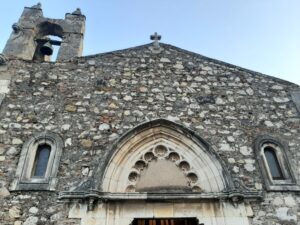 A corner of spirituality and craftsmanship
A corner of spirituality and craftsmanship
Inside, the single nave is simple yet rich in meaning. A niche decorated with gray Taormina marble holds a wooden statue of the saint, depicted in episcopal robes, mitre on his head, pastoral staff in his left hand, and his right hand raised in blessing—a gesture conveying protection and serenity.
The true centerpiece remains the Nativity scene, a work of folk art accessible year-round. With precision and care, it portrays both the sacred and urban character of Taormina.
Recognizable elements include:
- The Greek Theatre
- The Cathedral and Palazzo Corvaja
- Piazza IX Aprile and the Clock Tower
- The Church of Saint Joseph and the former Church of Saint Augustine
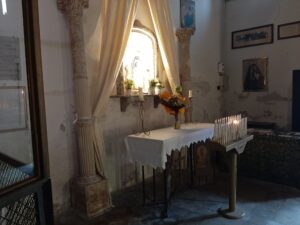 Every detail—mountains, pathways, and tiny figures—brings this visual narrative to life, celebrating both Taormina’s beauty and the spirit of Christmas.
Every detail—mountains, pathways, and tiny figures—brings this visual narrative to life, celebrating both Taormina’s beauty and the spirit of Christmas.
Fascinating details
- The perforated lead windows are a rare Byzantine decorative feature on the main and side façades.
- The 17th-century bell tower, with its small bells beneath arches, adds historical charm.
- The annual animal blessing on January 17th blends religious and rural tradition.
A place to experience
Though no longer used for religious services, the church is open daily as a cultural and devotional space. Located just outside Porta Catania, it’s often the first monument encountered when entering the historic center—an ideal gateway to the city’s cultural richness.
Its location and architectural beauty make it perfect for visitors wanting to explore Taormina’s authentic soul. Each stone and every detail of the Nativity scene is a page from the city’s shared memory.
 A miniature Taormina that tells a timeless story
A miniature Taormina that tells a timeless story
The permanent Nativity scene housed in the Church of Saint Anthony Abbot is more than a religious display—it’s a tribute to Taormina’s cultural identity. Crafted in 1953 by Dionisio Cacopardo, the scene features scaled replicas of the city’s most iconic landmarks, all made from hand-carved cork and local materials. This miniature cityscape blends sacred imagery with urban architecture, offering a unique perspective on both.
Among the monuments represented are:
- The Greek Theatre
- The Cathedral and Palazzo Corvaja
- Piazza IX Aprile and the Clock Tower
- The Church of Saint Joseph and the former Church of Saint Augustine
- Palazzo Duca di Santo Stefano and Palazzo Badia Vecchia
The landscape includes hills, valleys, winding paths, and tiny figures that animate the scene. Visitors often describe it as “a miniature Taormina,” praising its craftsmanship and emotional resonance.
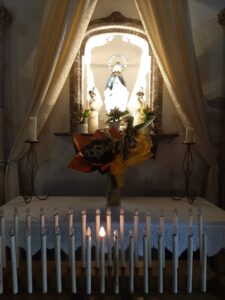 A gateway to discovery
A gateway to discovery
Located in Piazza Sant’Antonio Abate, just outside Porta Catania, the church is often the first historical site encountered when entering Taormina’s old town. Its strategic position makes it easily accessible, especially for those arriving by car and parking nearby.
Though no longer used for religious services, the church is open daily from 9:30 AM to 8:30 PM. It serves as a cultural and devotional space, welcoming visitors to explore its architecture, history, and the enchanting Nativity scene.
A place to remember
The Gothic portal, Byzantine-style windows, and Baroque bell tower create a facade that’s both photogenic and historically rich. Inside, the single nave and the statue of Saint Anthony Abbot offer a quiet space for reflection. The Nativity scene, with its intricate details and heartfelt storytelling, leaves a lasting impression.
This small church, often overlooked, holds within its walls the essence of Taormina—its resilience, its artistry, and its devotion. Whether you’re a history enthusiast, a lover of craftsmanship, or simply a curious traveler, the Church of Saint Anthony Abbot invites you to step into a story that continues to unfold.

